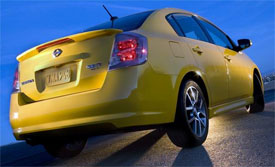2007 Nissan Sentra SE-R Spec-V
Sport sedans are four-door fun, especially nimble little pocket rockets like Nissan Sentra’s SE-R, and its gutsier partner, the SE-R Spec-V. And each time Nissan revamps the Sentra, new SE-Rs soon follow. So let’s see if Nissan’s latest potent little powerhouses are still a pocket-full of fun.
It’s been five years since MotorWeek put the Nissan Sentra SE-R through its paces, so our staff was thrilled to see this 2007 Sentra SE-R Spec-V roll into our parking lot. But it didn’t stay parked for long as we couldn’t wait to wring-out Nissan’s smallest sport sedan.
Like before, the biggest difference between the SE-R and SE-R Spec-V is powertrain. Both start with a heavily revamped twin-cam 2.5-liter 4-cylinder engine. Output for the SE-R is 177 horsepower, that’s up 12, and 172 pound feet of torque. Our test Spec-V ups the ante further to a potent 200 horsepower and 180 pound-feet of torque.
There is also a big difference in gearboxes. The SE-R promotes Nissan’s CVT continuously-variable automatic with manual-mode paddle shifters. Meanwhile, our Spec-V only comes with a close ratio 6-speed manual, but there is an optional limited-slip front differential.
 With 200 ponies and the 6-speeds under foot, our Spec-V darted to 60 in 7-seconds flat. The quarter-mile passed swiftly in 15.4 seconds at 92 miles-per-hour. While only a tenth faster than the previous Spec-V, this 4 spins up faster, and is a whole lot smoother and quieter.
With 200 ponies and the 6-speeds under foot, our Spec-V darted to 60 in 7-seconds flat. The quarter-mile passed swiftly in 15.4 seconds at 92 miles-per-hour. While only a tenth faster than the previous Spec-V, this 4 spins up faster, and is a whole lot smoother and quieter.
It also boasts a wider spread of power, kicking hard from just 3,000 rpm. The once rubbery shifts are now short and solid, as the manual’s gear ratios are spot on.
Similar improvements lie in the suspension. Despite added size and weight, the SE-R Spec-V still responds expertly to driver inputs, and delivers tons of grip. The nervous feel of earlier versions has been greatly reduced.
Changes to the basic Sentra all-independent suspension include stiffer tuning on the SE-R, with lowered springs, larger front bar, and 17-inch summer performance tires on the Spec-V.
Front torque steer is also down a lot, but a lack of feedback from the electric power steering surprised us.
Also, braking comes up short by being so long. Despite custom calipers and oversized discs, average stops from 60 were 142 feet, but we don’t think that’s typical. The ABS-equipped discs were clearly scored and warped from over-enthusiastic testing before us.
SE-R street manners are extremely civilized for a performance car. The engine’s healthy torque makes it easy to putter along in stop-and-go traffic with minimal shifting. And the ride, while firm, is not overly harsh.
And it’s even good on gas. Government fuel economy ratings are 24 city/31 highway. Despite spirited driving, we managed 28 miles-per-gallon on premium gas. The Spec-V’s energy impact score is a very modest 12.7 barrels of oil per year.
The SE-R’s performance is wrapped in the newest Sentra orb-like body, but adds deeper front and rear fascias, lower side sills, and a rear deck spoiler, all typical of the performance import breed.
 Plus unique sporty trim inside, that in our Spec-V includes cloth covered sport seats with contrasting red stitching, SE-R logos throughout, and red front seat belts.
Plus unique sporty trim inside, that in our Spec-V includes cloth covered sport seats with contrasting red stitching, SE-R logos throughout, and red front seat belts.
The dash features additional instruments; a g-meter and an oil pressure. And either a standard 160-watt audio setup, or the optional 340-watt Rockford Fosgate system.
The use of Nissan’s longer-wheelbase C-platform for the current Sentra line means the Spec-V even boasts respectable rear leg room and a practical 12 cubic-foot trunk. But you do surrender cargo flexibility as a “V” chassis brace eliminates the standard Sentra’s split-folding seat backs.
Pricing for the Nissan Sentra SE-R starts at only $19,400. Just $500 more will net you our Spec-V with an extra 23 horsepower for $19,900. And it’s money well spent if you’re a long time Nissan fan who remembers the thrills of earlier SE-Rs, but maybe you’re now just a little bit older and softer.
Indeed, the new SE-Rs may not have all the edginess of earlier efforts, but they are still impressive sport sedans for the money. A pair of pocket-size powerhouses that still deliver loads of driving fun.
Specifications
- Engine: Twin-cam 2.5-Liter 4-Cylinder
- Horsepower: 200
- Torque: 180 Lb Feet
- 0-60 MPH: 7.0 Seconds
- 1/4 Mile: 15.4 Seconds @ 92 MPH
- 60-0 MPH: 142 Feet
- EPA: 24 MPG City/ 31 MPG Highway
- Mixed Loop: 28 MPG
- Energy Impact Score: 12.7 Barrels Of Oil/year






